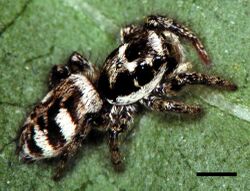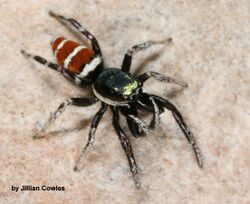Biology:Salticus
| Salticus | |
|---|---|

| |
| Female Salticus scenicus | |
| Scientific classification | |
| Domain: | Eukaryota |
| Kingdom: | Animalia |
| Phylum: | Arthropoda |
| Subphylum: | Chelicerata |
| Class: | Arachnida |
| Order: | Araneae |
| Infraorder: | Araneomorphae |
| Family: | Salticidae |
| Subfamily: | Salticinae |
| Genus: | Salticus Latreille, 1804[1] |
| Type species | |
| Salticus scenicus (Clerck, 1757)[1]
| |
| Species | |
|
See text. | |
| Synonyms | |
Salticus (from Latin “saltus” – leap or jump[2]) is a genus of the family Salticidae (the jumping spiders). Salticus is the type genus for the family Salticidae.[3]
Description
Coloration is determined by various scales (modified setae) covering a brown or black integument. Narrow scales (or hairs) may be black or red/rust colored, while broad scales are either iridescent (often magenta or green) or opaque granular white or yellow.[4]
Several common species have a dorsal pattern of black narrow scales and white granular scales arranged in transverse stripes, especially on the abdomen, from which the common name “zebra spiders” originates, e.g. Holarctic Salticus scenicus (Clerck, 1757). Some Salticus species in the Southwestern US and Mexico have red and white transverse stripes on the abdomen, e.g. Salticus palpalis (Banks, 1904). Some lack the “zebra” stripes completely and have both dorsal abdomen and cephalothorax covered with iridescent scales, e.g. Salticus peckhamae (Cockerell, 1897).[5] Since the dorsal coloration does not seem to be involved in the male’s courtship display the coloration may have been selected for camouflage or mimicry. For example, there is a strong similarity between S. palpalis and Agapostemon sweat bees.[6]
Salticus species range in length from 3-7 mm.[5][7] Males are smaller than females, but have elongated chelicerae and pedipalps.
Habits
Like most Salticidae, they prefer open, sunny habitats They are often found on vertical surfaces including man-made structures such as walls and fences or natural such as tree trunks. They are commonly found near water, where they feast on emergent aquatic gnats and other insects. One study recorded dipterans as 70% of prey items.[1] Salticus species have been observed preying on insects several times their body size.
Distribution
This genus has at least one species recorded from every continent except Antarctica. One common species, S. scenicus, is a widely distributed Holarctic species associated with human habitations. S. scenicus has the second most jumping spider observations on iNaturalist. Most other Salticus species have a more restricted distribution. Two areas with high species diversity are the Southwestern portion of the United States (into Mexico) and the Mediterranean. Four species have been recorded from the Canary Islands
Species
File:Salticus cingulatus - Burgwald 2011.ogv (As of July 2020), the World Spider Catalog accepted these species:[1]
- Salticus afghanicus Logunov & Zamanpoore, 2005 – Afghanistan
- Salticus aiderensis Logunov & Rakov, 1998 – Turkmenistan
- Salticus alegranzaensis Wunderlich, 1995 – Canary Is.
- Salticus annulatus (Giebel, 1870) – South Africa
- Salticus austinensis Gertsch, 1936 – United States, Mexico, Central America
- Salticus beneficus (O. Pickard-Cambridge, 1885) – China (Yarkand)
- Salticus bonaerensis Holmberg, 1876 – Argentina
- Salticus brasiliensis Lucas, 1833 – Brazil
- Salticus canariensis Wunderlich, 1987 – Canary Is.
- Salticus cingulatus (Panzer, 1797) – Europe, Turkey, Iran, Russia (Europe to Far East), Kazakhstan, Mongolia
- Salticus confusus Lucas, 1846 – Portugal, Spain, France (Corsica), Bulgaria, Greece (Crete), Algeria
- Salticus conjonctus (Simon, 1868) – France, Italy
- Salticus coronatus (Camboué, 1887) – Madagascar
- Salticus devotus (O. Pickard-Cambridge, 1885) – China (Yarkand)
- Salticus dzhungaricus Logunov, 1992 – Kazakhstan, Turkmenistan
- Salticus falcarius (Hentz, 1846) – United States
- Salticus flavicruris (Rainbow, 1897) – Australia (New South Wales)
- Salticus gomerensis Wunderlich, 1987 – Canary Is.
- Salticus insperatus Logunov, 2009 – Iran
- Salticus iteacus Metzner, 1999 – Greece
- Salticus jugularis Simon, 1900 – Australia (Queensland)
- Salticus karakumensis Logunov & Ponomarev, 2020 – Turkmenistan
- Salticus kraali (Thorell, 1878) – Indonesia (Ambon)
- Salticus latidentatus Roewer, 1951 – Russia (South Siberia, Far East), Mongolia, China, Japan
- Salticus lucasi Zamani, Hosseini & Moradmand, 2020 – Iran (named for Lucas the Spider[8])
- Salticus major (Simon, 1868) – Portugal, Spain, France
- Salticus mandibularis (Simon, 1868) – Greece
- Salticus meticulosus Lucas, 1846 – Algeria
- Salticus modicus (Simon, 1875) – France
- Salticus mutabilis Lucas, 1846 – Europe, Savage Is., Azores, Morocco, Egypt, Georgia, Argentina
- Salticus noordami Metzner, 1999 – Greece, Turkey, Cyprus, Israel, Iran
- Salticus olivaceus (L. Koch, 1867) – Spain to Israel
- Salticus palpalis (Banks, 1904) – United States, Mexico
- Salticus paludivagus Lucas, 1846 – Algeria
- Salticus peckhamae (Cockerell, 1897) – United States
- Salticus perogaster (Thorell, 1881) – Papua New Guinea (Yule Is.)
- Salticus propinquus Lucas, 1846 – Mediterranean
- Salticus proszynskii Logunov, 1992 – Kyrgyzstan, Kazakhstan
- Salticus quagga Miller, 1971 – Hungary, Slovakia
- Salticus ravus (Bösenberg, 1895) – Canary Is.
- Salticus ressli Logunov, 2015 – Turkey
- Salticus scenicus (Clerck, 1757) (type species) – North America, Europe, Russia (Europe to Far East), Caucasus, Kazakhstan, Iran
- Salticus scitulus (Simon, 1868) – France (Corsica)
- Salticus tricinctus (C. L. Koch, 1846) – Mediterranean to Central Asia, Afghanistan
- Salticus truncatus Simon, 1937 – France
- Salticus turkmenicus Logunov & Rakov, 1998 – Turkmenistan
- Salticus unciger (Simon, 1868) – Southern Europe
- Salticus unicolor (Simon, 1868) – Greece (Corfu)
- Salticus zebraneus (C. L. Koch, 1837) – Europe, Turkey, Russia (Europe, Caucasus), Iran
References
- ↑ 1.0 1.1 1.2 "Species list for Salticus", World Spider Catalog (Natural History Museum Bern), https://www.wsc.nmbe.ch/specieslist/2941, retrieved 2020-07-20
- ↑ "Latin Definition for: saltus, saltus (ID: 33976) - Latin Dictionary and Grammar Resources - Latdict". https://latin-dictionary.net/definition/33976/saltus-saltus.
- ↑ Edwards, G.B. (2011). "A review of the type designations of the genus Salticus Latreille, genus Attus Walckenaer, and the family Salticidae Blackwall (Arachnida: Araneae), with special reference to historical connections with the Genus Myrmarachne MacLeay". Peckhamia 93:1: 1–11. https://peckhamia.com/peckhamia/PECKHAMIA_93.1.pdf.
- ↑ HILL, DAVID EDWIN (1979). "The scales of salticid spiders". Zoological Journal of the Linnean Society 65 (3): 193–218. doi:10.1111/j.1096-3642.1979.tb01091.x. ISSN 0024-4082.
- ↑ 5.0 5.1 Peckham, George Williams (1909) (in en). Revision of the Attidae of North America. Democrat Printing Company, State Printer. https://books.google.com/books?id=VkwbAAAAYAAJ&q=peckham+1909&pg=PA355.
- ↑ Cowles, Jillian (2018-06-12) (in en). Amazing Arachnids. Princeton University Press. ISBN 978-0-691-17658-1. https://books.google.com/books?id=_3GYDwAAQBAJ&q=amazing+arachnids&pg=PA7.
- ↑ Bellmann, Heiko (2011). Nueva Guia de Campo de Aracnidos de Europa. Barcelona, Spain: Ediciones Omega. ISBN 978-84-282-1558-9.
- ↑ Zamani, Alireza; Hosseini, Marzieh Sadat; Moradmand, Majid (2020), "New data on jumping spiders of Iran, with a new species of Salticus (Araneae: Salticidae)", Arachnology Letters 59: 63–66, doi:10.30963/aramit5908
Further reading
- Murphy, Frances & Murphy, John (2000): An Introduction to the Spiders of South East Asia. Malaysian Nature Society, Kuala Lumpur.
External links
- Dr. Heiko Metzner's Worldwide Database of Jumping Spiders (includes descriptions, distribution maps, drawings/photos for most species listed in the World Spider Catalog) [2]
- Video of Salticus scenicus [3]
Wikidata ☰ Q1720738 entry
ro:Salticinae
 |



